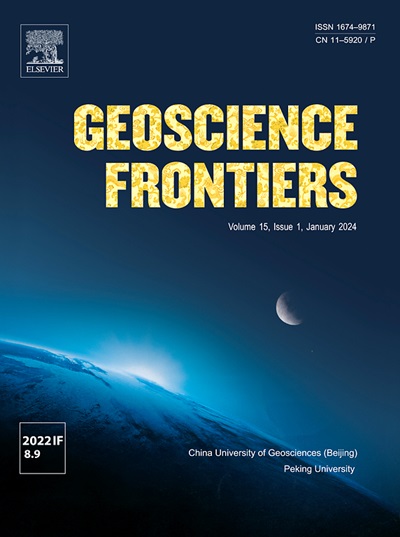Contribution of pegmatite shells to magmatic evolution and rare metal mineralization: Insights from the Shihuiyao deposit, Inner Mongolia, Northeast China
IF 8.9
1区 地球科学
Q1 GEOSCIENCES, MULTIDISCIPLINARY
引用次数: 0
Abstract
Highly evolved granite associated with pegmatite shells exhibits significant potential for rare metal mineralization; however, the mechanisms through which these pegmatite shells contribute to magmatic evolution and rare metal enrichment remain poorly understood. The Late Jurassic Shihuiyao Nb–Ta–(Rb–Be–Li) deposit is one of the largest rare-metal deposits in the Southern Great Xing’an Range (SGXR), Northeast China. Exploratory trenches expose distinct layered zones from top to bottom: alternating microcline pegmatite and aplite layers (zone I), topaz lepidolite albite granite and lepidolite amazonite pegmatite (zone II), and muscovite albite granite (zone III). We conducted U–Pb dating of cassiterite, monazite, and Nb–Ta oxide, monazite Nd isotopes, and whole-rock and mineral geochemistry for the three zones. Multi-mineral U–Pb ages indicate that the three zones formed during the Late Jurassic–Early Cretaceous (147–142 Ma). Geochemical analyses of whole-rock, mica, and microcline suggest an evolutionary sequence from zone I to zone III, and finally to zone II. The Zr/Hf, Nb/Ta, Y/Ho, and K/Rb ratios combined with the rare earth element (REE) tetrad effects suggest higher degree of differentiation and fluid–melt interaction of the Shihuiyao leucogranite without a pegmatite shell compared to coeval barren granites from both Shihuiyao and the SGXR. A progressive increase in the degree of evolution is evident from the leucogranite without a pegmatite shell to the leucogranite with a discontinuous shell, and ultimately to the leucogranite with a continuous shell. The pegmatite shell acted as a geochemical barrier that facilitated the accumulation of Li and F in the underlying magma, which played a crucial role in lowering the solidus temperature of the granitic magma. This process prolonged the crystallization duration while reducing melt viscosity and density, thereby creating favorable conditions for magma differentiation and fluid–melt interaction. Rapid crystallization of the earlier water- and Be-rich melt led to the Be mineralization in the pegmatite shell. Moreover, the formation of this shell served as a barrier for Li mineralization in the underlying topaz lepidolite albite granite. This study enhances our understanding of the critical contribution of pegmatite shells to magmatic evolution and rare-metal mineralization.

伟晶岩壳对岩浆演化和稀有金属成矿作用的贡献——来自内蒙古石辉窑矿床的启示
与伟晶岩壳伴生的高度演化花岗岩具有重要的稀有金属成矿潜力;然而,这些伟晶岩壳对岩浆演化和稀有金属富集的作用机制尚不清楚。晚侏罗世石辉窑铌钽(Rb-Be-Li)矿床是大兴安岭南段最大的稀有金属矿床之一。勘探沟从上到下暴露出不同的层状带:微斜长伟晶岩和阿长石交替层(带I),黄玉绢云石钠长石花岗岩和绢云石amazonite伟晶岩(带II),白云石钠长石花岗岩(带III)。我们对这三个带进行了锡石、独居石和Nb-Ta氧化物的U-Pb测年,独居石Nd同位素,以及全岩和矿物地球化学分析。多矿物U-Pb年龄表明,这三个带形成于晚侏罗世-早白垩世(147-142 Ma)。全岩、云母和微斜岩的地球化学分析表明其演化顺序从ⅰ区到ⅲ区,最后到ⅱ区。Zr/Hf、Nb/Ta、Y/Ho和K/Rb比值以及稀土元素四元体效应表明,石辉窑无辉晶岩壳的浅白色花岗岩与石辉窑和SGXR同时期的贫花岗岩相比,具有更高的分异程度和流体-熔融相互作用。从无伟晶岩壳的浅花岗岩体到具有不连续壳的浅花岗岩体,最终到具有连续壳的浅花岗岩体,其演化程度逐渐增加。伟晶岩壳作为地球化学屏障,促进了下伏岩浆中Li和F的富集,对降低花岗岩岩浆的固相温度起着至关重要的作用。这一过程延长了结晶时间,降低了熔体粘度和密度,为岩浆分化和液-熔相互作用创造了有利条件。早期富水富Be熔体的快速结晶导致伟晶岩壳中Be矿化。此外,该壳层的形成对下伏黄玉锂云母钠长石花岗岩中的锂矿化起到了屏障作用。该研究加深了我们对伟晶岩壳在岩浆演化和稀有金属成矿作用中的重要作用的认识。
本文章由计算机程序翻译,如有差异,请以英文原文为准。
求助全文
约1分钟内获得全文
求助全文
来源期刊

Geoscience frontiers
Earth and Planetary Sciences-General Earth and Planetary Sciences
CiteScore
17.80
自引率
3.40%
发文量
147
审稿时长
35 days
期刊介绍:
Geoscience Frontiers (GSF) is the Journal of China University of Geosciences (Beijing) and Peking University. It publishes peer-reviewed research articles and reviews in interdisciplinary fields of Earth and Planetary Sciences. GSF covers various research areas including petrology and geochemistry, lithospheric architecture and mantle dynamics, global tectonics, economic geology and fuel exploration, geophysics, stratigraphy and paleontology, environmental and engineering geology, astrogeology, and the nexus of resources-energy-emissions-climate under Sustainable Development Goals. The journal aims to bridge innovative, provocative, and challenging concepts and models in these fields, providing insights on correlations and evolution.
 求助内容:
求助内容: 应助结果提醒方式:
应助结果提醒方式:


